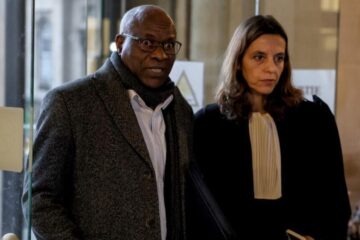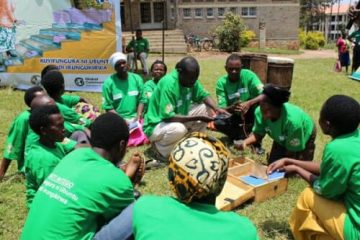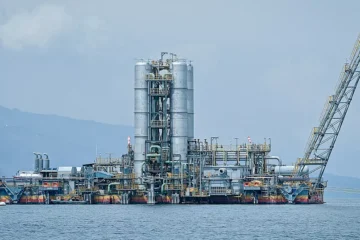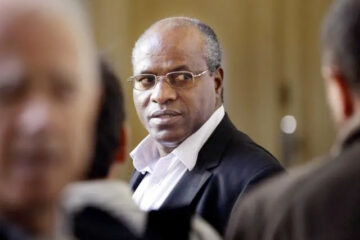For years, the shadowy underworld of illegal mining has silently thrived in Rwanda’s Southern Province, leaving a trail of devastation in its wake. Entire families have been torn apart, widows left clutching fading memories, children forced into adulthood earlier, and parents drowning in sorrow that seems endless. Amid this chaos, one question looms unanswered: who are the faceless orchestrators behind this relentless tragedy?
“One morning, while I was at work, people came to inform me that my 15-year-old son had died in the mine. At first, I refused to believe them. I convinced myself he might only be injured, that we could rush him to the hospital and get him treated. My mind was filled with endless hopes and possibilities about his condition, anything but death. But when the rescuers finally reached him deep inside the mine, they found that he was already gone.” Said Helena Mutimukeye (names changed), a 47-year-old mother.
Mutimukeye continues her story: “The moment I was informed, I raced down the mountain, desperate to see for myself. Before I could reach the mine, one of my children called and told me it was over. They urged me not to waste my time rushing there, my son was already gone.
I couldn’t bring myself to accept the truth. It’s impossible to believe without seeing the body with your own eyes. They retrieved his body from the depths of the mine and carried it, laying him on a makeshift board fashioned from tree branches. Step by step, they climbed the mountain, bearing his lifeless form to the health center. Along the way to the hospital, someone with a car took pity on them and offered to help.
At first, I felt nothing. But the moment I saw his body, the reality sank in. Thoughts of my son consumed me, the painful realization that I would never see him again. As I looked around, I saw other children his age, and in that instant, I lost my grip on reality. I could no longer hold myself together. Having struggled with blood pressure issues, I went into a crisis and had to be rushed to Rukoma Hospital. The nurses tried to comfort me, but their words couldn’t reach me. My grief was so overwhelming that I could no longer think clearly.
In the mines, there’s no discrimination, people of all ages go there. When it comes to earning money from minerals, everyone rushes to it. My son was among them. He would sometimes skip school to work in the mines, driven by a strong desire to earn his own money. He wanted to buy the things other kids his age had, things we, as his family, couldn’t provide for him. We weren’t okay with him skipping school to chase money, but as parents who struggled to provide enough to keep him away from these dangerous jobs, we had no choice but to accept the harsh reality.”
Lost life, lost memory
Mutimukeye’s story is only one of many; these treacherous mines have stolen countless lives, leaving behind families crushed by sorrow and communities haunted by loss. Each tragedy is a stark reminder of the cost of desperation and negligence, and the grief left behind is immeasurable.
The story of Theresa Kayitesi (names changed) is one of profound heartache, a tale too heavy for words to fully capture. For three long years, she has lived with the agony of her husband’s death in the mine, a grave tragedy made even more unbearable by the fact that his body remains trapped beneath the earth. He was never brought home for a proper burial, leaving her and their four children in an endless cycle of grief and unanswered prayers.
“One morning, he left home to tend to the land, just as he always did,” she recalls. “Later, I received news that the mine had collapsed. I was stunned, confused. How could he have ended up there when he never worked in the mine?”
She continues with trembling words: “It was raining heavily that day when the government authorities arrived with their machines. They worked tirelessly, getting so close to reaching him, but then the rain became relentless, forcing them to stop and remove the equipment. They told me to wait until summer, promising they would return to resume the search.”
But summer came and went, and no one returned. Desperate for answers, Kayitesi asked for help, only to be told that if her family had the means, they could attempt to retrieve him themselves. Otherwise, they would have to wait for investors, who might someday continue the work and recover his body.
“Some of the miners later told me they had found him,” she says, her voice breaking. “But they didn’t bring him out. I begged them to at least mark the spot where he rests, so I wouldn’t have to endure the thought of them digging elsewhere and disturbing his final resting place.” She added.
Who’s the mysterious employer?
Mutimukeye never had the chance to meet the person who employed her son. The shadowy figure remained hidden, detached from the pain their actions caused. Her grief was compounded by the knowledge that there was no accountability, no face to confront, and no answers to the questions that lingered in her heart.
“In all of this, no one stepped forward claiming to be his employer, not even once. They explained that the mine was illegal, with no insurance, no accountability, and no intervention from whoever oversaw the operation. Despite this, there was undeniably an employer, a shadowy figure, but one who exists. Someone funds the operation, pays the workers, and ensures the minerals extracted from the mine make their way to the market, just like those from legal mines.” She said.
Locals suggest the authorities to be accomplices …
The illegal mining site, surprisingly located between two legitimate mines, raises significant concerns. As Mutimukeye noted, “What adds to the confusion is that this illegal mine is situated right between two fully legal mines. Both companies operate within the law, while the illegal miners, commonly known as ‘abahebyi’, continue their work in plain daylight. The local authorities, and even the police, are fully aware of their activities. Yet, mysteriously, no action is taken, they remain untouched.”

The mining sites in Rukoma sector, Kamonyi district, one legally operated by SRMC Ltd and the other one operated illegally by ‘Abahebyi’
During our visit, we observed the miners working openly, seemingly unconcerned by our presence. Nearby mine workers revealed that the operators were aware of who we were long before we arrived, relying on their trustworthy intelligence.
Following this, we visited a nearby bar-restaurant, where clients recounted stories tied to the mining industry. One striking account described the bar owner’s swift transition from a minor cell staff position to acquiring significant wealth and multiple mining sites in just one year. Another story highlighted a scandal involving a national police district officer, who was arrested for corruption related to illegal mining. These narratives reflect the complex and troubling dynamics of unchecked mining activities intertwined with power and corruption.
Some police operations …
In November 2024, Rwanda national police (RNP) published a report on their operations targeting illegal mining in southern province.
“RNP, in collaboration with local authorities in the Southern Province, intensified operations against illegal mining activities. During an operation on November 4, at least 51 individuals were arrested across Muhanga, Kamonyi, and Ruhango districts, with 700 kilograms of minerals, including cassiterite, lithium, and coltan, seized alongside tools such as generators and weighing scales.” The report said.
Netting small fishes
Police operations targeting illegal mining activities are frequent in the region, but the arrests are limited to small-scale miners. No buyers or intermediaries who transport the minerals to official mining counters have been apprehended, leaving a significant gap in addressing the deeper layers of this illicit trade.
A senior officer from a well-known local mining company, whose identity remains undisclosed, shed light on how minerals from illegal mines manage to infiltrate legal markets.
“Illegal mining is an undeniable reality.” The person said. “This issue persists largely because many mines in the Southern Province were shut down for failing to meet legal standards. Even with the closures, locals haven’t stopped mining these sites. The minerals they extract are gathered by brokers, people often known in the community as shopkeepers or seed sellers in nearby centers. These brokers then sell the minerals to legal companies operating in the area.
The companies, equipped with valid mining licenses, have access to authentic mineral tags used to seal the bags of minerals for transport to official counters. Through this process, illegally obtained minerals are seamlessly mixed with legal ones, making their way to the market as if they were mined lawfully.” The person added.
The person further revealed the existence of illegal mining counters, operations without proper licenses that still manage to function under the guise of legality. These counters blend seamlessly into the system, making it difficult to distinguish them from legitimate ones.
Another troubling issue involves employees of legal mining companies. “Some workers steal minerals from their own companies,” the source explained. ‘They sell these stolen minerals to rival firms, driven by financial desperation. The pay they receive from their employers is often much less than what they can earn through this illicit trade. This double betrayal not only undermines the companies but also feeds into the cycle of fraudulent mineral trade.” The person added.
The minerals’ journey …
A source that is experienced in mining activities shared with us the journey of the minerals from the mine to the mining counter.

The mining site legally operated
“Mining tags in Rwanda are issued by the Rwanda Mines, Petroleum and Gas Board (RMB). These tags are part of the mineral traceability system, which is supposed to ensure that minerals are sourced responsibly and legally. The process involves tagging minerals at the point of extraction to track their journey through the supply chain. This system is supposed to help prevent illegal mining and smuggling.” The source stated.
The source elaborates on the realities of mining operations. “Obtaining a mining license, though issued by the government, is not accessible to everyone. The sector is largely monopolized by influential individuals with significant, though discreet, power. Those unable to secure a license are compelled to work under licensed operators through what is commonly referred to as ‘sous-traitance.’
Licensed companies receive tags based on their operating areas and production specifications. These tags include numbers and accompanying fiches that specify the type and quantity of minerals to be sealed, as pre-declared during the licensing process. Minerals are required to be treated and sealed at their mining sites before being transported to official mining counters, which ensure no fraud occurs during transit. ‘Sous-traitants’ mine and deliver minerals to the license holders, referred to as their ‘god-fathers.’
However, this arrangement facilitates illegal mining, as ‘sous-traitants’ resort to various means to meet their quotas, including hiring brokers to source minerals from illegal miners. Since these minerals remain within the designated areas, they are indistinguishable from legally mined ones, eventually getting tagged and transported together to official counters.”
We reached out to the RMB for a response to the claims mentioned above, and they responded that “We can’t comment on questions about illegal mining and its associated issues.”
We also contacted the southern province administration for a response. Despite several attempts to communicate directly with Governor Ms. Alice Kayitesi, she redirected us to her advisor, Mr. Alfred Bikomo, who has yet to provide any feedback or commentary.
Some have a lot to lose
Licensed mining companies in Rwanda face ongoing challenges from illegal mining activities, which undermine lawful operations and threaten compliance with regulations. Dieudonné Nshimiyimana, a miner with SRMC Ltd, highlights that despite significant investments in adhering to legal and environmental standards, companies struggle to retain employees who are tempted by higher pay in illegal operations.

Emmanuel Kinyogote, a miners’ representative in the southern province, also emphasizes the disruption caused by illegal miners, locally known as “Abahebyi.” These individuals disregard safety protocols and intrude on closed mines, endangering lives and hindering the efforts of legitimate businesses to operate ethically and profitably.
Both parties emphasize the need for government intervention to streamline the licensing process, enabling companies to legally hire miners, safeguard lives and businesses, and ensure environmental protection.
According to Rwanda development board, Rwanda possesses rich mineral deposits, including tin, tantalum, tungsten (3Ts), and gold, alongside rare earth elements and industrial minerals like granite and clay. Mining has been a cornerstone of the country’s economy since the 1930s, with export earnings rising from $373.4 million in 2017 to $1.1 billion in 2023. The sector annually produces 8,000–9,000 tons of 3Ts, playing a vital role in Rwanda’s economic growth.
According to National Institute of Statistics of Rwanda, mining production in Rwanda increased 4.30 percent in January of 2025 over the same month in the previous year. Mining Production in Rwanda averaged 11.94 percent from 2012 until 2025, reaching an all-time high of 377.20 percent in July of 2022 and a record low of -72.90 percent in December of 2020.
The law regulating labor in Rwanda clearly states that no child is permitted to work in the mines, setting the minimum age for employment at 18. Yet, in some sectors mining remains the backbone of survival for 70 percent of the population. Most of those relying on mining are teenagers who shy away from working on farms, eager to support their families or earn their own income, end up risking their safety and futures in unregulated and dangerous conditions.
Author: AF








